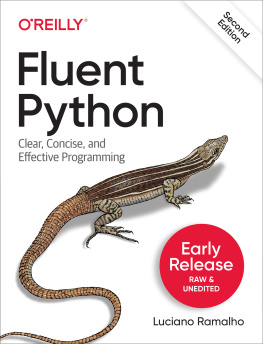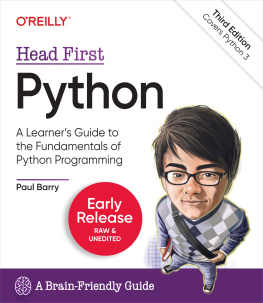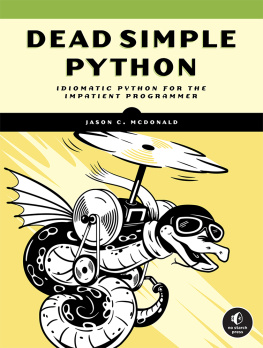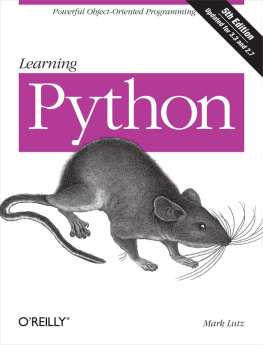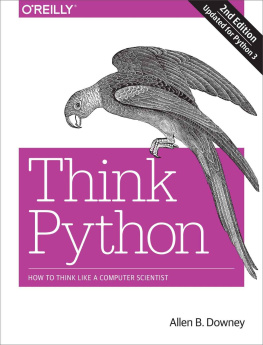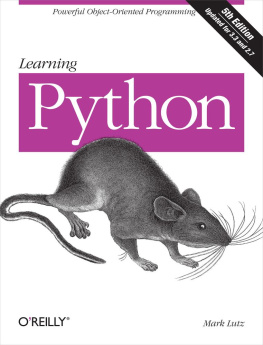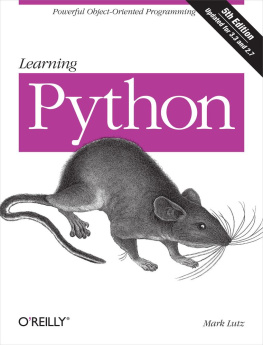Warning
The Preface has not been updated from the First Edition.This will be the last part of the book to be updated for the Second Edition.
Heres the plan: when someone uses a feature you dont understand, simply shoot them. This is easier than learning something new, and before too long the only living coders will be writing in an easily understood, tiny subset of Python 0.9.6 .
Tim Peters, Legendary core developer and author of The Zen of Python
Python is an easy to learn, powerful programming language. Those are the first words of the official Python Tutorial. That is true, but there is a catch: because the language is easy to learn and put to use, many practicing Python programmers leverage only a fraction of its powerful features.
An experienced programmer may start writing useful Python code in a matter of hours. As the first productive hours become weeks and months, a lot of developers go on writing Python code with a very strong accent carried from languages learned before. Even if Python is your first language, often in academia and in introductory books it is presented while carefully avoiding language-specific features.
As a teacher introducing Python to programmers experienced in other languages, I see another problem that this book tries to address: we only miss stuff we know about. Coming from another language, anyone may guess that Python supports regular expressions, and look that up in the docs. But if youve never seen tuple unpacking or descriptors before, you will probably not search for them, and may end up not using those features just because they are specific to Python.
This book is not an A-to-Z exhaustive reference of Python. Its emphasis is on the language features that are either unique to Python or not found in many other popular languages. This is also mostly a book about the core language and some of its libraries. I will rarely talk about packages that are not in the standard library, even though the Python package index now lists more than 60,000 libraries and many of them are incredibly useful.
Who This Book Is For
This book was written for practicing Python programmers who want to become proficient in Python 3. If you know Python 2 but are willing to migrate to Python 3.4 or later, you should be fine. At the time of this writing, the majority of professional Python programmers are using Python 2, so I took special care to highlight Python 3 features that may be new to that audience.
However, Fluent Python is about making the most of Python 3.4, and I do not spell out the fixes needed to make the code work in earlier versions. Most examples should run in Python 2.7 with little or no changes, but in some cases, backporting would require significant rewriting.
Having said that, I believe this book may be useful even if you must stick with Python 2.7, because the core concepts are still the same. Python 3 is not a new language, and most differences can be learned in an afternoon. Whats New in Python 3.0 is a good starting point. Of course, there have been changes since Python 3.0 was released in 2009, but none as important as those in 3.0.
If you are not sure whether you know enough Python to follow along, review the topics of the official Python Tutorial. Topics covered in the tutorial will not be explained here, except for some features that are new in Python 3.
Who This Book Is Not For
If you are just learning Python, this book is going to be hard to follow. Not only that, if you read it too early in your Python journey, it may give you the impression that every Python script should leverage special methods and metaprogramming tricks. Premature abstraction is as bad as premature optimization.
How This Book Is Organized
The core audience for this book should not have trouble jumping directly to any chapter in this book. However, each of the six parts forms a book within the book. I conceived the chapters within each part to be read in sequence.
I tried to emphasize using what is available before discussing how to build your own. For example, in , because I believe its important to be comfortable using an ABC before writing your own.
This approach has a few advantages. First, knowing what is ready to use can save you from reinventing the wheel. We use existing collection classes more often than we implement our own, and we can give more attention to the advanced usage of available tools by deferring the discussion on how to create new ones. We are also more likely to inherit from existing ABCs than to create a new ABC from scratch. And finally, I believe it is easier to understand the abstractions after youve seen them in action.
The downside of this strategy are the forward references scattered throughout the chapters. I hope these will be easier to tolerate now that you know why I chose this path.
Here are the main topics in each part of the book:
A single chapter about the Python Data Model explaining how the special methods (e.g., __repr__) are the key to the consistent behavior of objects of all typesin a language that is admired for its consistency. Understanding various facets of the data model is the subject of most of the rest of the book, but provides a high-level overview.

